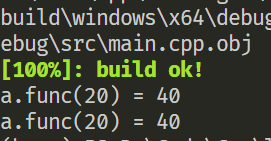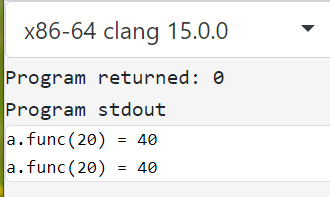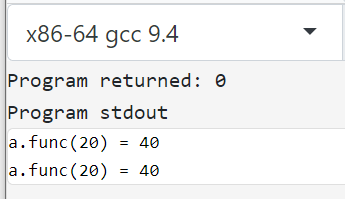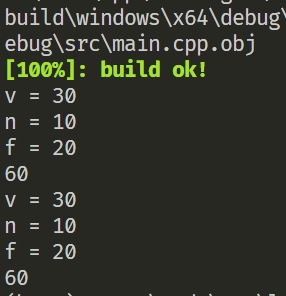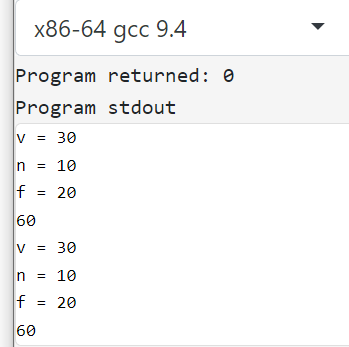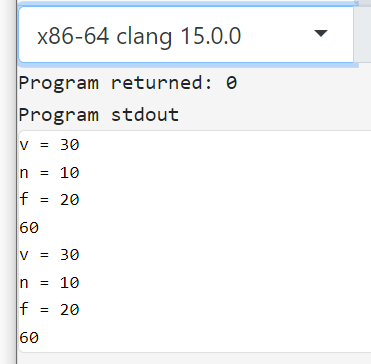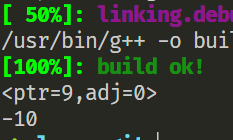刷牛客时经常能刷到面向对象相关的题目,多态作为面向对象中的一个重要特性(封装,继承和多态),在八股中经常考察其实现原理。为了方便理解,我们给出一个简单的多态样例
1 2 3 4 5 6 7 8 9 10 11 12 13 14 15 16 17 18 19 class A {public : virtual int func1 (int v) return value + v; } virtual int func2 (int v) return value - v; } int func3 (int v) return value * v; } static int func4 (int v) return v * 2 ; } public : int value{0xfeff }; }; class B : public A {public : int func1 (int v) override return value + 2 * v; } int func3 (int v) return value * 2 * v; } public : int value{0xfffd }; };
接下来就是经典调用函数写输出
1 2 3 4 5 6 7 8 9 10 11 12 13 int main (int argc, char **argv) B b; b.value = 2 ; A *a = &b; a->value = 4 ; int v = 20 ; fmt::print ("b.A::value={}\nb.B::value={}\n" , b.A::value, b.B::value); fmt::print ("a->func1({}) = {}\n" , v, a->func1 (v)); fmt::print ("a->func2({}) = {}\n" , v, a->func2 (v)); fmt::print ("a->func3({}) = {}\n" , v, a->func3 (v)); fmt::print ("a->func4({}) = {}\n" , v, a->func4 (v)); return 0 ; }
执行如下
1 2 3 4 5 6 7 8 (base) PS D:\Code\Cpp\learn-git> xmake -brv learn-git && xmake run learn-git [100%]: build ok! b.A::value=4 b.B::value=2 a->func1(20) = 42 a->func2(20) = -16 a->func3(20) = 80 a->func4(20) = 40
执行结果不难想到,根据虚函数运行时绑定的特性(晚绑定),通过基类调用虚函数时会根据实际类型调用对应的函数。对于非虚函数则是直接调用普通的成员函数(是
A 类时调用 A::func3,是 B 类时调用
B::func3),且需要调用的函数在编译期间就已经确定好了。
成员函数指针
例子就介绍到这,下面我们要简单理解 C++
中实现原理,首先从成员函数指针来看,对于任意一个类别的成员函数,我们可以使用类似与函数指针的表达方式,即void(T::*)(),写成模板形式的话如下(当然,使用
auto 是最简单的,就是容易变成 auto
script,然后导致代码理解起来有困难)
1 2 3 template <class T , typename R, typename ... Args> struct MemberFuncPtr { using type = R (T::*)(Args...); };
例如 A::func1 就可以采用如下的定义方式
1 MemberFuncPtr<A, void >::type ptr_test = &A::test;
可以看到,其实际上就是
void (A::*)(),但是这样比写函数指针稍微舒服一点,我们可以通过
.* 和 ->* 的方式来调用成员函数指针
1 2 (a->*ptr_test)(); ((*a).*ptr_test)();
除此之外,我们也可以使用 std::function
的方式来封装封装成员函数,在函数的入参添加 A* 或
A& 参数接口(对于 const 的函数还需要添加
const 修饰符
1 std::function<void (A*)> std_ptr_test = &A::test;
然后在调用这个函数时将对象指针也作为参数传递过去即可
最后总结一下调用成员函数的几种方式(”茴“字的 4
种写法
1 2 3 4 5 6 7 a->test (); MemberFuncPtr<A,void >::type ptr_test = &A::test; (a->*ptr_test)(); std::function<void (A*)> std_ptr_test = &A::test;
之所以出现后面两种写法,主要就是为了实现
Delegate,当我们需要由代码来决定成员函数的调用时机时(例如事件响应等),我们就可以使用后面两种调用方式,不过在我们这里主要是探究虚函数的调用机制。
成员函数指针的大小?
当我们通过 &A::test
拿到成员函数的地址时,我们自然将其联想到和普通函数指针大小一致,但是不然,其大小与不同的编译器有关(或者更准确的说,与
C++ Compiler ABI 有关)。
我们在 Compiler Explorer
中进行运行测试(不支持 MSVC Compiler 的运行测试,但是可以测试 Clang 和
GCC)
1 2 3 4 5 6 7 8 9 10 11 #include <iostream> class A {public : virtual void func () }; int main () using namespace std; cout << "sizeof &A::func = " << sizeof (&A::func) << endl; return 0 ; }
测试结果如下表所示
Compiler
Output
x86-64 gcc 9.4
16
x86-64 clang 15.0.0
16
x86-64 msvc v19.25.28614 (default)
8
x86-64 msvc v19.25.28614
(single_inheritance)
8
x86-64 msvc v19.25.28614
(multiple_inheritance)
16
x86-64 msvc v19.25.28614
(virtual_inheritance)
24
注:关于 MSVC 的成员函数指针大小的设置,参考pointers_to_members
pragma | Microsoft Learn ,可以手动指定成员函数指针形式
1 #pragma pointers_to_members( full_generality, virtual_inheritance )
single_inheritance 表示单继承
multiple_inheritance 表示多继承
virtual_inheritance 表示虚继承
如果不指定,就是根据函数类型自动选择空间最小的表示方式(也就是混合上面三种表示方式)
虚表和虚指针
对于一个包含虚函数的类而言,其会在类的起始处添加一个指向虚表的指针(vtable),称为虚指针(vptr)(在
MSVC C++ 中称为 vftable 和 vfptr)
虚表中存储了各种各样的类别数据信息(RTTI等),也存储了虚函数的实际地址,通过虚指针和虚表,我们就可以在运行过程中动态解析函数地址并进行调用。
MSVC、Clang 以及 GCC 中都提供了类内存布局查看的命令
1 2 3 4 5 6 7 g++ -fdump-lang-class=- test.cpp clang++-15 -Xclang -fdump-record-layouts test.cpp clang++-15 -Xclang -fdump-vtable-layouts test.cpp cl /d1 reportAllClassLayout test.cpp
我们可以使用一个简单的类测试
1 2 3 4 5 6 7 8 9 10 11 12 class A {public : virtual void func () public : int n{0xfffd }; }; int main () A a; a.func (); return 0 ; }
x86-64 gcc 9.4 输出结果
1 2 3 4 5 6 7 8 9 10 11 12 ➜ src g++ -fdump-lang-class=- test.cpp Vtable for A A::_ZTV1A: 3 entries 0 (int (*)(...))0 8 (int (*)(...))(& _ZTI1A) 16 (int (*)(...))A::func Class A size=16 align=8 base size=12 base align=8 A (0x0x7ff174281420) 0 vptr=((& A::_ZTV1A) + 16)
x86-64 clang 15.0.7 输出结果
1 2 3 4 5 6 7 8 9 10 11 12 13 14 15 16 17 18 19 20 ➜ src clang++-15 -Xclang -fdump-record-layouts test.cpp *** Dumping AST Record Layout 0 | class A 0 | (A vtable pointer) 8 | int n | [sizeof=16, dsize=12, align=8, | nvsize=12, nvalign=8] *** Dumping IRgen Record Layout ... ➜ src clang++-15 -Xclang -fdump-vtable-layouts test.cpp Vtable for 'A' (3 entries). 0 | offset_to_top (0) 1 | A RTTI -- (A, 0) vtable address -- 2 | void A::func() VTable indices for 'A' (1 entries). 0 | void A::func()
x86-64 msvc 19.25.28614 输出结果
1 2 3 4 5 6 7 8 9 10 11 12 13 14 15 (base) PS D:\Code\Cpp\learn-git> cl /d1 reportAllClassLayout test.cpp ... class A size(16): +--- 0 | {vfptr} 8 | n | <alignment member> (size=4) +--- A::$vftable@: | &A_meta | 0 0 | &A::func A::func this adjustor: 0
从图中我们可以看出,三个编译器给出的虚表结构以及内存布局基本一致,虚指针都位于类的前8字节,可以使用
reinterpret_cast
来读取,而虚表本质上是一个指针数组。我们可以尝试直接从虚表中拿到虚函数的真实地址进行调用。代码如下
1 2 3 4 5 6 7 8 9 10 11 12 13 14 15 16 17 18 19 20 #include <iostream> class A {public : virtual int func (int v) return v + 20 ; } }; int main () A a; uintptr_t *vptr = *reinterpret_cast <uintptr_t **>(&a); uintptr_t ptr_func = vptr[0 ]; using Func = int (*)(A *, int ); Func f = reinterpret_cast <Func>(ptr_func); int res = f (&a, 20 ); std::cout << "a.func(20) = " << res << std::endl; res = a.func (20 ); std::cout << "a.func(20) = " << res << std::endl; return 0 ; }
uintptr_t 表示和指针大小一致的整型数,在 64 位平台上就为
uint64_t,使用这个方便跨平台使用
如果调用调用正确,我们可以看到两行一样的输出
输出的确如我们所愿(x86-64 msvc 19.25.28614)
再在 compiler explorer 上跑下 GCC 和 Clang 的结果
GCC 执行结果
这个例子比较简单,没有考虑继承情况,以及最关键的 this
指针问题,下面给一个稍微复杂一点的例子
1 2 3 4 5 6 7 8 9 10 11 12 13 14 15 16 17 18 19 20 21 22 23 24 25 26 27 28 29 30 31 32 33 34 35 36 37 38 39 40 41 42 #include <iostream> class A {public : A (int n) : n (n) {} virtual int func (int v) std::cout << "v = " << v << std::endl; std::cout << "n = " << n << std::endl; return v + n; } public : int n{0xfffd }; }; class B : public A {public : B (int n, int f) : A (n), f (f) {} virtual int func (int v) std::cout << "v = " << v << std::endl; std::cout << "n = " << n << std::endl; std::cout << "f = " << f << std::endl; return v + n + f; } public : int f{0xfffd }; }; int main () B b (10 , 20 ) ; A *a = &b; uintptr_t *vptr = *reinterpret_cast <uintptr_t **>(&b); uintptr_t ptr_func = vptr[0 ]; using Func = int (*)(A *, int ); Func f = reinterpret_cast <Func>(ptr_func); int res = f (a, 30 ); std::cout << res << std::endl; res = a->func (30 ); std::cout << res << std::endl; return 0 ; }
MSVC 执行结果
GCC 执行结果
Clang 执行结果
虚函数调用过程
最后,我们尝试理解成员函数指针到底是什么?为什么其比寻常的函数指针更大?
我们直接将其转换成字节数组,然后读取其值
1 2 3 4 5 6 7 8 9 10 11 12 13 14 15 16 17 18 19 20 21 22 23 24 25 #include <iomanip> #include <iostream> class A {public : virtual void func () }; template <class T , typename Ret, typename ... Args> struct MemberFuncPtr { using type = Ret (T::*)(Args...); }; int main () A a; constexpr size_t size_a = sizeof (&A::func); uint8_t bytes[size_a]; MemberFuncPtr<A, void >::type ptr = &A::func; std::copy (&ptr, &ptr + size_a, bytes); std::cout << "[ " ; for (uint8_t v : bytes) { std::cout << std::setbase (16 ) << std::setw (2 ) << (uint32_t )v << " " ; } std::cout << "]" << std::endl; return 0 ; }
这个结果会随着编译器不同有所改变,在 MSVC 下,输出结果如下
1 [ 4d 40 8c 7a f7 7f 0 0 ]
而在 Clang 和 GCC 下,二者输出都是
1 [ 1 0 0 0 0 0 0 0 0 0 0 0 0 0 0 0 ]
一个好像看不出什么结果,我们多弄点类和继承,再来看看效果
测试代码
1 2 3 4 5 6 7 8 9 10 11 12 13 14 15 16 17 18 19 20 21 22 23 24 25 26 27 28 29 30 31 32 33 34 35 36 37 38 39 40 41 42 43 44 45 46 47 48 49 50 51 52 53 54 55 56 57 #include <array> #include <iomanip> #include <iostream> class A {public : virtual void func1 () virtual void func2 () }; class B {public : virtual void func3 () virtual void func4 () }; class C : public A, public B {}; template <class T , typename Ret, typename ... Args> struct MemberFuncPtr { using type = Ret (T::*)(Args...); }; template <class T , typename Ret, typename ... Args>void print_bytes (typename MemberFuncPtr<T, Ret, Args...>::type func_ptr) constexpr size_t size = sizeof (func_ptr); std::array<uint8_t , size> content; uint8_t *arr = reinterpret_cast <uint8_t *>(&func_ptr); std::copy (arr, arr + size, content.begin ()); std::cout << "[ " ; for (uint8_t v : content) { std::cout << std::setbase (16 ) << std::setw (2 ) << (uint32_t )v << " " ; } std::cout << "]" << std::endl; } int main () A a; std::cout << "&A::func1" << std::endl; print_bytes <A, void >(&A::func1); std::cout << "&A::func2" << std::endl; print_bytes <A, void >(&A::func2); std::cout << "&B::func3" << std::endl; print_bytes <B, void >(&B::func3); std::cout << "&B::func4" << std::endl; print_bytes <B, void >(&B::func4); std::cout << "&C::func1" << std::endl; print_bytes <C, void >(&C::func1); std::cout << "&C::func2" << std::endl; print_bytes <C, void >(&C::func2); std::cout << "&C::func3" << std::endl; print_bytes <C, void >(&C::func3); std::cout << "&C::func4" << std::endl; print_bytes <C, void >(&C::func4); return 0 ; }
输出结果
msvc (添加 /RTC1 标志,将所有未初始化的栈上内存标记为
0xcc )
1 2 3 4 5 6 7 8 9 10 11 12 13 14 15 16 &A::func1 [ a2 40 4e 34 f6 7f 0 0 ] &A::func2 [ 87 1a 4e 34 f6 7f 0 0 ] &B::func3 [ b8 2a 4e 34 f6 7f 0 0 ] &B::func4 [ bf 3c 4e 34 f6 7f 0 0 ] &C::func1 [ a2 40 4e 34 f6 7f 0 0 0 0 0 0 cc cc cc cc ] &C::func2 [ 87 1a 4e 34 f6 7f 0 0 0 0 0 0 cc cc cc cc ] &C::func3 [ b8 2a 4e 34 f6 7f 0 0 8 0 0 0 cc cc cc cc ] &C::func4 [ bf 3c 4e 34 f6 7f 0 0 8 0 0 0 cc cc cc cc ]
GCC / Clang
1 2 3 4 5 6 7 8 9 10 11 12 13 14 15 16 &A::func1 [ 1 0 0 0 0 0 0 0 0 0 0 0 0 0 0 0 ] &A::func2 [ 9 0 0 0 0 0 0 0 0 0 0 0 0 0 0 0 ] &B::func3 [ 1 0 0 0 0 0 0 0 0 0 0 0 0 0 0 0 ] &B::func4 [ 9 0 0 0 0 0 0 0 0 0 0 0 0 0 0 0 ] &C::func1 [ 1 0 0 0 0 0 0 0 0 0 0 0 0 0 0 0 ] &C::func2 [ 9 0 0 0 0 0 0 0 0 0 0 0 0 0 0 0 ] &C::func3 [ 1 0 0 0 0 0 0 0 8 0 0 0 0 0 0 0 ] &C::func4 [ 9 0 0 0 0 0 0 0 8 0 0 0 0 0 0 0 ]
C++ 代码
1 print_bytes <A, void >(&A::func1);
可以对应到下面的汇编
MSVC
1 2 lea rcx, OFFSET FLAT:[thunk]:A::`vcall' {0 ,{flat}}' }' ; A::`vcall' {0 }' call void print_bytes <A,void >(void (__cdecl A::*)(void )) ; print_bytes<A,void >
GCC 对应调用的汇编
1 2 3 4 5 6 7 8 9 10 11 mov r12d, 1 mov r13d, 0 mov rcx, r12 mov rbx, r13 mov rax, r12 mov rdx, r13 mov rax, rdx # 最终 rdi = 1 , rsi = 0 ,也就是输入到函数的参数 mov rdi, rcx mov rsi, rax call void print_bytes <A, void >(MemberFuncPtr<A, void >::type)
Clang 对应汇编
1 2 3 4 5 6 7 mov qword ptr [rbp - 24 ], 0 mov qword ptr [rbp - 32 ], 1 # 最终 rdi = 1 , rsi = 0 ,也就是输入到函数的参数 mov rdi, qword ptr [rbp - 32 ] mov rsi, qword ptr [rbp - 24 ] call void print_bytes <A, void >(MemberFuncPtr<A, void >::type) mov rdi, qword ptr [rbp - 160 ] # 8 -byte Reload
从结果中可以很清楚的看到,MSVC 和 GCC、Clang
的输出结果完全不一样,但从 MSVC
的结果上来看,存储的确实应该是一个指针,对于多继承情况下还包含一个4字节(uint32_t)的偏移量,而
GCC 和 Clang 是两个64位的值。
根据网上搜集的资料,我们可以得到这两个结构体的含义
MSVC C++ ABI member function pointer 结构体
1 2 3 4 5 6 7 8 9 10 11 12 13 struct member_func_info { uintptr_t ptr; }; struct member_func_info { uintptr_t ptr; uint32_t adj; };
GCC / Clang Itanium C++ ABI member function pointer 结构体
1 2 3 4 5 6 7 struct member_func_info { uintptr_t ptr; ptrdiff_t adj; };
在 x86-64 上,通过 ptr
的最后一位判断是否是虚函数,因为虚函数指针大小为 8 字节,也就是说 ptr
的值一定是偶数,即 ptr 的最后一位永远都是
0,这样对于普通函数而言,这个值就为偶数,而虚函数则是奇数。
在 arm 上,对于虚函数的判断方式转换成了 adj,通过 adj
的最后一位标识是否是虚函数
这一点我们同样可以从汇编代码上看出来
C++代码
1 print_bytes<A, void>(&A::func1);
对应 ARM64 汇编
1 2 3 4 5 6 7 8 movs r3, #0 str r3, [r7, #8] movs r3, #1 str r3, [r7, #12] add r3, r7, #8 ldm r3, {r0, r1} # 最终传入的值为 {0x0,0x1} bl void print_bytes<A, void>(MemberFuncPtr<A, void>::type)
这样,我们可以尝试解析成员函数指针并进行调用(仅限于 Itanium C++
ABI,也就是 GCC 和 Clang,对于 MSVC
实在是没办法,居然是又新增了一段跳转函数,属实是恶心人了)
1 2 3 4 5 6 7 8 9 10 11 12 13 14 15 16 17 18 19 20 21 22 23 24 25 26 27 28 29 30 31 32 33 34 35 36 37 38 39 40 41 42 43 44 45 46 47 48 49 50 51 52 53 54 55 56 57 58 #include <array> #include <cstdint> #include <iomanip> #include <iostream> class A {public : A (int n) : n (n) {} virtual int func1 (int v) return n + v; } virtual int func2 (int v) return n - v; } int n{0xfffd }; }; template <class T , typename Ret, typename ... Args> struct MemberFuncPtr { using type = Ret (T::*)(Args...); }; struct member_func_info { uintptr_t ptr; ptrdiff_t adj; }; template <class T , typename Ret, typename ... Args>member_func_info from_raw (typename MemberFuncPtr<T, Ret, Args...>::type func_ptr) return *reinterpret_cast <member_func_info *>(&func_ptr); } template <class T , typename Ret, typename ... Args>Ret invoke (T *obj, typename MemberFuncPtr<T, Ret, Args...>::type func_ptr, Args &&...args) uintptr_t ptr_this = reinterpret_cast <uintptr_t >(obj); member_func_info func_info = from_raw <T, Ret, Args...>(func_ptr); std::cout << "<ptr=" << func_info.ptr << ",adj=" << func_info.adj << ">" << std::endl; uintptr_t adj_this = ptr_this + func_info.adj; uintptr_t vptr = *reinterpret_cast <uintptr_t *>(adj_this); uintptr_t func_address = vptr + func_info.ptr & (~0x1 ); using Func = Ret (*)(T *, Args...); Func f = *reinterpret_cast <Func *>(func_address); return f (obj, std::forward<Args>(args)...); } int main () A a{10 }; std::cout << invoke <A, int >(&a, &A::func2, 20 ) << std::endl; return 0 ; }
执行结果
对于 clang 也是一样
总结
虚函数的出现是因为我们无法在静态编译过程中确定要执行的函数,需要动态查找待执行的函数 。具体而言就是通过对象示例中存储的一个指向虚函数表(vtable)的虚指针(vptr),结合待调用的虚函数信息(在
vtable 上的偏移量)获取到实际的函数地址,最后调用函数。
对于普通的函数而言,在静态编译过程中能够获取到函数地址,而虚函数则多了一个查找的过程(虚继承情况可能还要再多一次虚基的寻址过程)。

